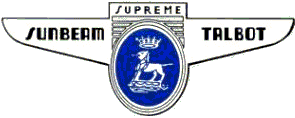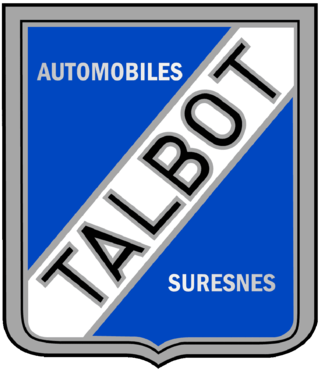Related Research Articles

The Rover Company Limited was a British car manufacturing company that operated from its base in Solihull, Warwickshire. Its lasting reputation for quality and performance was such that its first postwar model reviewed by Road & Track in 1952 was pronounced finer than any but a Rolls-Royce. Rover also manufactured the Land Rover series from 1948 onwards, which spawned the Range Rover in 1970, and went on to become its most successful and profitable product — with Land Rover eventually becoming a separate company and brand in its own right.

Alvis Car and Engineering Company Ltd was a British manufacturing company in Coventry from 1919 to 1967. In addition to automobiles designed for the civilian market, the company also produced racing cars, aircraft engines, armoured cars and other armoured fighting vehicles.

Sunbeam Motor Car Company Limited was a British automobile manufacturer in operation between 1905 and 1934. Its works were at Moorfields in Blakenhall, a suburb of Wolverhampton in Staffordshire, now West Midlands. The Sunbeam name had originally been registered by John Marston in 1888 for his bicycle manufacturing business. Sunbeam motor car manufacture began in 1901. The motor business was sold to a newly incorporated Sunbeam Motor Car Company Limited in 1905 to separate it from Marston's pedal bicycle business; Sunbeam motorcycles were not made until 1912.
Carbodies was a taxi design and manufacturing company based in Coventry, England. In its latter years it also traded as London Taxis International and The London Taxi Company.
SS Cars was a British manufacturer of sports saloon cars from 1934 until wartime 1940, and from March 1935 of a limited number of open 2-seater sports cars. From September 1935, their new models displayed a new name: SS Jaguar. By then, its business, which was founded in 1922, was run by and largely owned by William Lyons. Lyons had been partner with 1922 co-founder William Walmsley until Walmsley sold his shareholding in January 1935.

The Rover 10 was a small family car from the British Rover car company produced between 1927 and 1947.

The Rover Meteor was a short-lived 2½-litre or 2-litre medium-sized car made by The Rover Company Limited of Meteor Works Coventry. The new 2½-litre model was announced in mid-February 1930 to supplement Rover's Light Twenty which used the same engine and essentially the same chassis.

James Young Limited was a top class British coachbuilding business in London Road, Bromley, England.

Sunbeam-Talbot Limited was a British motor manufacturing business. It built upmarket sports-saloon versions under the parenthood of Rootes Group cars from 1938 to 1954. Its predecessor Clément-Talbot Limited had made Talbot automobiles from 1902 to 1935.

The Sunbeam-Talbot 90 is an automobile which was produced and built by Sunbeam-Talbot from 1948 to 1954 and continued as the Sunbeam Mk III from 1954 to 1957.

The Alvis TA 14, also called the Alvis Fourteen, was the first car that the car maker and defence contractor Alvis cars produced after World War II. The entire car factory had been destroyed on the night of Thursday 14 November 1940. Announced in November 1946, it was made until 1950, when its postwar austerity 1900 cc engine was replaced by the 2993 cc 26.25 HP Alvis Three Litre or TA 21.

The Alvis 12/70 was announced by Alvis cars 22 September 1937. It was a four-cylinder sports saloon or 4-seater drophead coupé related to the pricier six-cylinder Alvis Silver Crest.

The Sunbeam-Talbot Ten is a compact executive car or small sports saloon manufactured by Rootes Group in their Clément-Talbot factory in North Kensington between 1938 and 1939, and then reintroduced after the Second World War and sold between 1945 and 1948. It was at first a two-door then a four-door sports saloon. A drophead coupé version and a sports tourer version were also available.

STD Motors, formerly Darracq & Company, was a French manufacturer of motor vehicles and aero engines based in Suresnes near Paris. The French enterprise, known at first as A. Darracq et Cie, was founded in 1896 by Alexandre Darracq after he sold his Gladiator Bicycle business. In 1903 Darracq sold the business to A Darracq and Company Limited of England, taking a substantial shareholding himself.
The Rover Fourteen was a medium-sized family car and variants produced by the British Rover car company between 1924 and 1948. Civilian automobile production was interrupted in 1940 because of the war, but when the war ended in 1945, the Rover 14 returned to the market and remained available until replaced by the Rover 75 at the beginning of 1948.

The Vauxhall Cadet VY is an automobile produced by Vauxhall from 1930 until 1933. It was an entirely new model announced by Vauxhall on 6 October 1930. The first Vauxhall priced below £300, it was intended to supplement the existing 24 h.p. 20-60 thereafter to be known as the Vauxhall Eighty. When exported it was usually supplied with a 27 h.p. engine and named VX. The first truly new Vauxhall since General Motors' purchase of the business in 1925, it was an American-style car with certain local amendments.

The Carlton Carriage Company was a London coachbuilder that provided bespoke coachwork for some of the finest car makers of the 1920s and 1930s. They are best known for their drophead coupes which are archetypal designs of the British Jazz Era.

The Vauxhall 20-60 is a four or five-seater saloon, limousine, tourer or coupé-cabriolet manufactured by Vauxhall of Luton. It was announced on 28 September 1927 with a six-cylinder engine and a four-speed gearbox. A cautious move downmarket. "The first time any six-cylinder Vauxhall has been sold under £1000!" "British & Vauxhall". The initial 2.7-litre engine was enlarged to 3-litres after twelve months.

Automobiles Talbot France was the French subsidiary of British automotive manufacturer S.T.D. Motors Ltd., established in 1920 after the merger of British automakers A Darracq and Company, Clément-Talbot, and Sunbeam Company. Automobiles Talbot manufactured cars in Suresnes, near Paris.

Mayfair Carriage Co Limited owned a London coachbuilder and dealer in second hand large cars in Kilburn then, from 1934, at The Hyde, Edgware Road NW9.
References
- 1 2 Georgano, N. (2000). Beaulieu Encyclopedia of the Automobile. London: HMSO. ISBN 1-57958-293-1.
- ↑ "Highly Important Sale of Six Motor Cars". Northampton Mercury. 15 August 1902. p. 4.
- 1 2 3 4 5 "Records of Grose Holdings Ltd". The National Archive.
- 1 2 Nick Walker. A-Z of British Coachbuilders. Bay View Books 1997. ISBN 1-870979-93-1
- ↑ "Bodywork Exhibits at the Commercial Motor Show". Commercial Motor. 5 November 1929. p. 440.
- ↑ "Thornycroft Stand 58". Commercial Motor. 5 November 1937. p. 485.